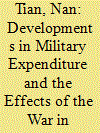| Srl | Item |
| 1 |
ID:
192037


|
|
|
|
|
| Summary/Abstract |
This article presents on trends in military spending, building on the most recent military expenditure data by the Stockholm International Peace Research Institute (SIPRI). World military spending grew for the eighth consecutive year in 2022, up 3.7 per cent to an all-time high of $2240 billion. The increase in world spending in 2022 was largely due to three factors: Russia’s invasion of Ukraine; the increase in military spending by Central and Western Europe countries as a reaction to the invasion and expenditure rises in major powers in Asia, namely China, India and Japan. There were two major military expenditure related developments in 2022 linked to the war in Ukraine. Firstly, Central and Western European responded to the deteriorating security situation by announcing plans to substantially increases their military spending. Some of the acutest increases in military spending took place in countries with close geographical proximity to Russia and Ukraine. Secondly were the immediate and record levels of military aid sent to Ukraine. Based on official figures for the largest donors and other assistance funds, at least $30 billion worth of military aid was given to Ukraine in 2022, with the US as the largest provider accounting for around two-thirds of all military aid
|
|
|
|
|
|
|
|
|
|
|
|
|
|
|
|
| 2 |
ID:
136965


|
|
|
|
|
| Summary/Abstract |
This paper examines the impact of military expenditure on economic growth on a large balanced panel, using an exogenous growth model and dynamic panel data methods for 106 countries over the period 1988–2010. A major focus of the paper is to consider the possibility group heterogeneity and non-linearity. Having estimated the model for all of the countries in the panel and finding that military burden has a negative effect on growth in the short and long run, the panel is broken down into various groupings based upon a range of potentially relevant factors, and the robustness of the results is evaluated. The factors considered are different levels of income, conflict experience, natural resources abundance, openness and aid. The estimates for the different groups are remarkably consistent with those for the whole panel, providing strong support for the argument that military spending has adverse effects on growth. There are, however, some intriguing results that suggest that for certain types of countries military spending has no significant effect on growth.
|
|
|
|
|
|
|
|
|
|
|
|
|
|
|
|